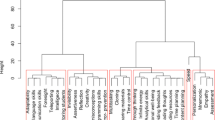Abstract
This article examines a technology-rich curriculum project that was implemented in China with in-service teachers during a three-year period. The findings suggest the need to support in-service teachers to implement new technology-rich curriculum. The findings also imply the need for curriculum designers to have a good understanding of not only their team members, but also of EFL (English as a Foreign Language) teachers in order to provide appropriate and relevant technology-rich curriculum. The authors suggest important related topics for further research, such as job-embedded professional development and professional learning communities.
Similar content being viewed by others
References
Beauvois, M. H. (1997). Computer-mediated communication: Technology for improving speaking and writing. In M. D. Bush (Ed.), Technology enhanced language learning (pp. 165–184). Lincolnwood, IL: National Textbook Company.
Borko, H., Jacobs, J., Eiteljorg, E., & Pittman, M. E. (2008). Video as a tool for fostering productive discussions in mathematics professional development. Teaching and Teacher Education, 24, 417–436.
Burke, M. B. (2011). Rituals and beliefs ingrained in world language pedagogy: defining deep structure and conventional wisdom. Journal of Language Teaching and Research, 2(1), 1–12.
Burns, M., & Dimock, K. V. (2007). Technology as a catalyst for school communities: Beyond boxes and bandwidth. Lanham: Rowman & Littlefield.
Cavanaugh, C. S. (2001). The effectiveness of interactive distance education technologies in K-12 learning: A meta-analysis. International Journal of Educational Telecommunications, 7(1), 73–88.
Chapelle, C. (2001). Computer applications in second language acquisition. Cambridge: Cambridge University Press.
Chun, D. M. (2007). Come ride the wave: but where is taking us? CALICO Journal, 24, 239–252.
Cohen, D. K. (1995). What is the system in systemic reform? Educational Researcher, 24(9), 11–17.
Corwin, R., Price, S. L., & Storeygard, J. (1996). Talking mathematics: Resources for developing professionals. Portsmouth: Heinemann.
Egorov, V. V., Jantassova, D. D., & Churchill, N. (2007). Developing pre-service English teachers’ competencies for integration of technology in language classrooms in Kazakhstan. Educational Media International, 44(3), 255–265.
Feiman-Nemser, S. (2001). From preparation to practice: Designing a continuum to strengthen and sustain teaching. Teachers College Record, 103, 1013–1055.
Gomez, M. L., Black, R. W., & Allen, A. R. (2007). “Becoming” a Teacher’. Teachers College Record, 109(9), 2107–2135.
Goos, M., & Bennison, A. (2002). Building learning communities to support beginning teachers’ use of technology. Proceedings of the annual conference of the Australian Association for Research in Education, Brisbane.
Grossman, P. L. (1991). Overcoming the apprenticeship of observation in teacher education coursework. Teaching and Teacher Education, 7, 245–257.
Grossman, P. (2005). Research on pedagogical approaches in teacher education. In M. Cochran-Smith & K. Zeichner (Eds.), Studying teacher education: The report of the AERA Panel on Research and Teacher Education (pp. 425–452). Mahwah: Lawrence Erlbaum.
Lave, J., & Wenger, E. (1991). Situated learning: Legitimate peripheral participation. Cambridge: University of Cambridge Press.
Li, G., & Ni, X. (2011). Primary EFL teachers’ technology use in China: Patterns and perceptions. RELC Journal, 42(1), 69–85.
Lindberg, J. O., & Olofsson, A. D. (Eds.). (2009). Online Learning Communities and Teacher Professional Development. IGI Global.
Lock, J. (2006). New image: Online communities to facilitate teacher professional development. Journal of Technology and Teacher Education, 14(4), 663–678.
Masats, D., & Dooly, M. (2011). Rethinking the use of video in teacher education: A holistic approach. Teaching and Teacher Education, 27(7), 1151–1162.
Mishra, P., & Koehler, M. J. (2006). Technological pedagogical content knowledge: A framework for teacher knowledge. Teachers College Record, 108(6), 1017–1054.
National Archives and Records Administration (2009, November 12). Department of Education, State Fiscal Stabilization Fund program: Final rule. Federal Register, 74(217), 58479–58525. Retrieved from http://edocket.access.gpo.gov/2009/pdf/E9-27161.pdf
Penny, A. R., & Coe, R. (2004). Effectiveness of consultation on student ratings feedback: A meta-analysis. Review of Educational Research, 74(2), 215–253.
Pierson, M. E. (2001). Technology integration practices as function of pedagogical expertise. Journal of Research on Computing in Education, 33(4), 413–429.
Preece, J. (2000). Online communities: Designing usability and supporting sociability. Chichester, UK: Willey.
Rich, P., & Hannafin, M. (2009). Scaffolded Video Self-Analysis: Discrepancies between Preservice Teachers’ Perceived and Actual Instructional Decisions. Journal of Computing in Higher Education, 21(2), 128–145.
Salazar, D., Aguirre-Munoz, Z., Fox, K., Nuanez-Lucas, L. (2009). Online professional learning communities: Increasing teacher learning and productivity in isolated rural communities. Retrieved from http://www.iiisci.org/journal/CV$/sci/pdfs/GE220YX.pdf
Saleh, S., & Pretorius, F. J. (2006). English as a foreign language: teachers’ professional development via the Internet. Progressio, 28(1 & 2), 111–126.
Sherin, M. G. (2003). New perspectives on the role of video in teacher education. Advances in Research on Teaching, 10, 1–27.
Shulman, L. S. (1987). Knowledge and teaching: Foundations of the new reform. Harvard Educational Review, 57, 1–22.
Spillane, J. P., & Jennings, N. E. (1997). Aligned instructional policy and ambitious pedagogy: Exploring instructional reform from the classroom perspective. Teachers College Record, 98(3), 439–481.
Velazquez-Torres, N. (2006). How well are ESL teachers being prepared to integrate technology in their classrooms? TESL-EJ, 9(4), 1–28.
Weick, K. E., Sutcliffe, K. M., & Obstfeld, D. (2005). Organizing and the process of sense making. Organization Science, 16(4), 409–421.
Zhao, Y. (1996). Language learning on the World Wide Web: Toward a framework of network based call. Calico Journal, 14, 37–57.
Zhao, Y. (2003). Recent developments in technology and language learning: A literature review and meta-analysis. CALICO Journal, 21(1), 7–27.
Author information
Authors and Affiliations
Corresponding author
Rights and permissions
About this article
Cite this article
Keengwe, J., Kang, JJ. Preparing in-service language teachers to design and implement technology-rich curriculum. Educ Inf Technol 18, 609–619 (2013). https://doi.org/10.1007/s10639-012-9195-y
Published:
Issue Date:
DOI: https://doi.org/10.1007/s10639-012-9195-y




